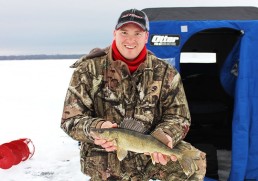Move Often, Fish Hard, Cash in on First-ice Flurry
SHARE THIS POST
Last year’s ice season could easily go down as the best ever. With good ice coming early and fish that were cooperating, just about everywhere you went the action was red hot. A lot of the evidence showed up on Facebook with countless pictures of panfish and walleyes posted, and there’s no doubt the fish took a beatin’. They probably had it coming though, as fish got off easy the prior season with all of the snow that made it almost impossible to get around, which severely restricted the catch. It’s too early to tell what this year will bring, but something normal and average would sure be nice.
Walleyes get a lot of the early attention, and rightly so. This is when they are relatively easy to find and as active as they are going to be. So, “Get ‘em while they’re hot” is the train of thought, and it’s why my first trips will focus primarily on ol’ marble eyes.
There are plenty of good opportunities for first ice ‘eyes, but one of the best is the Upper Red in northern Minnesota. The lake is chock-full of walleyes and they love to bite. So the Red is where my posse and I started last year’s ice fishing season. Another factor to start at the Red includes safe ice. The Red out-develops every other great walleye lake simply because it is relatively shallow and cools off more quickly. Last year, anglers found safe ice before Thanksgiving, which was really something to be thankful for. The walleyes were stacked up and biting from the time the first hole that was cut, and the action was incredible.
My crew decided last minute on an early trip to Red over another destination, which turned out to be a good move. When it was all done, they said they had never caught as many walleyes anywhere else and didn’t want to leave, even though yours truly wanted a change of venue with giant panfish in mind. Being outnumbered, we stayed with Red for the next few days and had a ball with plenty of catching and most of the fish that came through the holes were nice-sized keepers.
The key to it all was finding a concentration of fish, which included heading out past the first break line to deeper water (maybe 10 to 12 feet) and doing some serious jigging. Jigging with a spoon, to be exact, and the walleyes hit them hard and often. By dropping down a 1/16-ounce VMC Flash Champ spoon tipped with a minnow head or tail and watching the depth-finder, it didn’t take long to know if we were on the fish.
Are you enjoying this post?
You can be among the first to get the latest info on where to go, what to use and how to use it!
On a unit like Humminbird’s new Ice Helix 5, you can see the spoon, the tiny swivel above the spoon (if you’re using one, and you should be), and any fish that gets too close. The Helix 5 also has a GPS with a chart plotter, and it will display contour lines that reveal any break lines and structure. It’s an awesome and powerful feature, but when it comes to Red, you can basically forget about the structure and concentrate on the fish.
Other than the main shoreline break where shallower flats drop from 6 feet or so, to maybe 9 or 10, there just isn’t much for structure. There are a few offshore reefs out in the middle of the lake and they can produce later on in the season, but they get pounded and really aren’t that important to finding good numbers of fish, especially now. Early on, the action is much closer to shore and the fish are just about anywhere and everywhere, but they do bunch up. A move or two might be in order if things are a little slow to start with.
We made one move last year and actually fished the exact same holes two days in a row and kept the poles bending all day long. If the fish were there, they at least came in for a look and showed up as thick red marks on the ‘Bird and stayed fairly close to the bottom, at least to start with. If they came in but hesitated, we could get a lot of them to bit by lifting the bait up higher and giving it a light pump, followed by a stall. The higher they went, the more likely they were to give in and inhale the bait.
A second spoon down another hole in a stationary position also claimed its share of walleyes. It helped to keep walleyes in the vicinity, especially after a hit and miss where the minnow head was stripped off. Even though there had to be hundreds of walleyes in the area, they still came through in smaller packs. There was some wait time between flurries of pandemonium, but you could double the fun with a second rig.
MWO
SHARE THIS POST
Did you enjoy this post?
You can be among the first to get the latest info on where to go, what to use and how to use it!
Ron Anlauf
MidWest Outdoors works with more than 200 outdoor experts each year, who contribute articles based on their areas of expertise. MidWest Outdoors magazine offers more fishing and hunting articles than any other publication!



